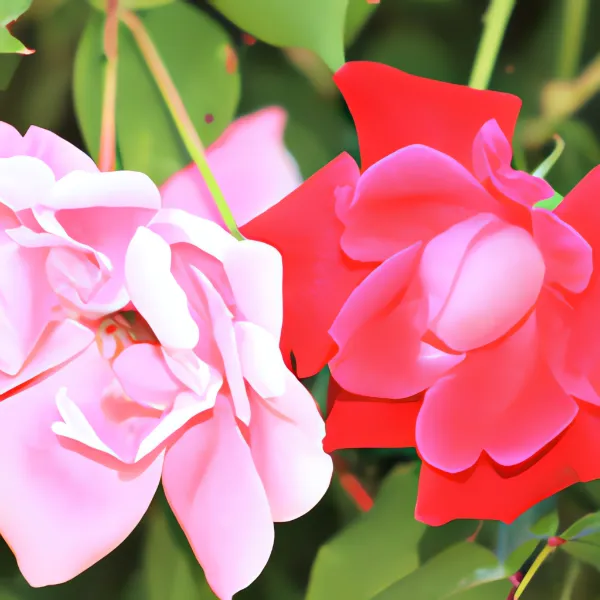What Is Meadow Rose? A Comprehensive Guide to Its Origin, Uses, Care & Facts
Are you ready to discover a plant that is not only beautiful but also essential for pollinators? Meet the Meadow Rose, also known as Rosa blanda, a deciduous shrub that belongs to the Rosaceae family.
This North American native can be found in dry, open woods, hills, prairies, and roadsides, and it boasts stunning pink or white flowers that bloom from May to August. But that’s not all! The Meadow Rose also produces red fruit that contains achenes and has several uses that you probably didn’t know about.
So, let’s dive into the origin, uses, care, and fascinating facts about this remarkable plant.

What Is Meadow Rose?
Meadow Rose, also known as Rosa Blanda or Smooth Rose, is a species of rose that is native to North America. It is a deciduous shrub that can grow up to 6 feet tall and 4 feet wide. This plant is a member of the Rosaceae family and is closely related to the Rosa Carolina or Early Wild Rose.
Origin
Meadow Rose is native to North America and can be found in the eastern and central parts of the United States and Canada. It grows naturally in meadows, prairies, and open woods. This plant is widely cultivated for its ornamental value and is used in landscaping and gardening.
Description
The Meadow Rose has a slender stem with small, prickly thorns. Its leaves are green and oval-shaped, and they turn yellow and red in the fall. The flowers of this plant are pink or white and bloom from June to August. The flowers have a pleasant fragrance and attract bees, butterflies, and other pollinators.
Characteristics
Meadow Rose is a hardy plant that can tolerate a wide range of soil types and growing conditions. It prefers full sun to partial shade and requires moderate watering. This plant is resistant to pests and diseases and is easy to grow. It is a popular choice for landscaping and is used in borders, hedges, and mass plantings.
Varieties
There are several varieties of Meadow Rose, including the Rosa Blanda var. borealis, Rosa Blanda var. Grandiflora, and Rosa Blanda var. neomexicana. These varieties differ in their flower color, size, and growth habit. Some varieties are more suitable for landscaping, while others are better suited for naturalizing.
Identification of Meadow Rose Species
Meadow Rose has several species, including Rosa blanda, Rosa carolina, Rosa palustris, and Rosa virginiana. Meadow Rose species can be recognized by their oval-shaped leaves with serrated edges, which grow in an alternate pattern on the stem. The flowers of Meadow Rose are typically pink or white and have a pleasant fragrance.
Uses of Meadow Rose
Meadow Rose is a versatile plant that has been used for centuries for its various benefits. Here are some of its uses:
Food
The rose hips of the Meadow Rose are edible and can be used in various recipes. They are a good source of Vitamin C and can be used to make jams, jellies, syrups, and teas. The rose hips can also be dried and used as a spice in cooking.
Teas
Meadow Rose tea is a popular way to enjoy the benefits of this plant. It is made by steeping the dried rose hips or the leaves and flowers in hot water. The tea is known for its anti-inflammatory properties and can help with conditions such as arthritis, gout, and other inflammatory conditions. It is also a natural diuretic and can help with urinary tract infections.
Medicine
Meadow Rose has been used in traditional medicine for its anti-inflammatory and diuretic properties. It can be used to treat conditions such as arthritis, gout, and other inflammatory conditions. The plant is also known for its ability to improve skin conditions such as acne and eczema. The rose hips can be used to make a tincture that can be used to treat various ailments.
Cosmetic Uses
The essential oil extracted from Meadow Rose is a popular ingredient in many cosmetic products. It is known for its anti-inflammatory and antibacterial properties and is often used in skincare products to reduce redness and soothe irritation.
Culinary Uses
Meadow Rose hips are often used in cooking to make jams, jellies, and syrups. They are also a good source of vitamin C and can be used to make teas and other beverages.
Ecological Uses
Meadow Rose is an essential plant for pollinators, providing a source of nectar and pollen for bees and other insects. Additionally, the plant provides nesting materials and structure for native bees.
Pet Safety
When it comes to our pets, particularly cats, it’s important to know the potential hazards posed by plants in our homes and gardens. While the Meadow Rose, along with other species of roses, can provide numerous benefits for humans,
it’s necessary to consider the possible effects they might have on our furry friends. To delve deeper into this topic, you may find our article Are Roses Toxic to Cats? extremely helpful.
Care of Meadow Rose
Meadow Rose is a low-maintenance plant that requires minimal care.
Here are some step-by-step instructions for caring for your Meadow Rose:
1. Watering
Meadow Rose requires average watering in spring and summer, but in the winter, it needs only occasional watering. During summer, you need to water it frequently to keep the soil moist.
2. Soil and pH
Meadow Rose grows well in well-drained soil with a pH level of either acidic or neutral. It prefers sandy or loamy soil that is rich in organic matter.
3. Plant Maintenance
Meadow Rose requires medium plant maintenance. It is susceptible to several diseases such as beetles, black spot, caterpillars, downy mildew, mosaic viruses, powdery mildew, rust, scale insects, and thripes. You should regularly monitor your plant for any signs of diseases and pests and take action immediately if you notice any issues.
4. Pruning
Meadow Rose needs regular pruning to maintain healthy growth and appearance. You should remove dead branches, damaged leaves, and dead leaves to prevent the spread of disease and promote new growth. Prune your plant during the dormant season or after flowering.
5. Planting
Meadow Rose can be propagated by stem cuttings or division of rootstock. Softwood cuttings should be taken with a heel and treated with hormone. The plant is also tolerant of drought and can be planted in containers, pots, or directly in the ground.
By following these simple care instructions, you can help ensure that your Meadow Rose grows and thrives in your garden. Regular monitoring, pruning, and watering can help keep your plant healthy and disease-free.
Facts About Meadow Rose
Meadow rose is a beautiful and easy-to-grow plant that can add a touch of elegance to any garden. Here are some interesting facts about this lovely plant:
Spread
The meadow rose can spread up to 6 feet wide, making it a great choice for filling in empty spaces in your garden.
Height
The meadow rose can grow up to 3 feet tall, making it a great choice for borders or as a focal point in your garden.
Leaves
The leaves of the meadow rose are dark green and glossy, with a serrated edge that adds texture to the plant.
Hips
The meadow rose produces small, bright red hips in the fall that are a favorite food of birds and other wildlife.
Bloom Time
The meadow rose blooms in early summer, producing large, fragrant flowers that can be white, pink, or red.
Color
The flowers of the meadow rose can be white, pink, or red, and they are often used in floral arrangements because of their beauty and fragrance.
Cultivation of Meadow Rose
When planting Meadow Rose, it is important to choose a location that has suitable growing conditions, including proper sunlight and soil drainage. To plant this beautiful shrub, dig a hole that is slightly larger than the root ball and place the plant in the hole, making sure to fill in with soil and water well after planting.
After planting, it is important to keep the plant well-watered until it is established in its new location. With the right care and attention, Meadow Rose can provide a beautiful addition to any garden or landscaping project.
Meadow Rose in North America
Native
Meadow Rose, also known as Wild Rose, is native to North America. It is a woody plant that belongs to the Rosaceae family. The plant is known for its beautiful flowers that bloom in the summer. The flowers are usually pink, but they can also be white or red.
Location
Meadow Rose can be found in many locations throughout North America. It is commonly found in meadows, prairies, and dry hillsides. The plant prefers well-drained soil and can grow in a variety of soil types.
Habitat
Meadow Rose is a natural plant that grows in the wild. It is often found in areas where other flora and fauna thrive. The plant provides a habitat for many wildlife species, including deer, which feed on its leaves and stems.
Wildlife
Meadow Rose is an important plant for many wildlife species. In addition to deer, the plant provides food and habitat for birds, insects, and other small animals. The plant is also used by humans for its medicinal properties.
Overall, Meadow Rose is a natural and important part of North America’s flora. While it can be invasive in certain areas, it is generally a beneficial plant that provides food and habitat for many wildlife species.
Meadow Rose in Europe and Asia
Origin
The Meadow Rose, also known as Rosa blanda, is a species of rose native to North America. However, it has been introduced and naturalized in many parts of Europe and Asia. It is believed that the Meadow Rose was brought to Europe by early settlers who admired its beauty and fragrance.
Spread
The Meadow Rose has become a popular ornamental plant in Europe and Asia due to its attractive pink flowers and sweet fragrance. It has been cultivated in gardens and parks, and it is also used as a hedge plant.
The smooth rose (Rosa carolina) is a close relative of the Meadow Rose and is also commonly found in Europe and Asia.
Varieties
There are many varieties of Meadow Rose that have been developed for their different characteristics. Some of the most popular varieties include the thornless Meadow Rose, climbing Meadow Rose, and those with double petals. The USDA has also developed a number of hybrid varieties that are disease-resistant and produce larger fruits.
The Meadow Rose is an important plant for pollinating insects, especially bees. Its stamens are covered in pollen, which is collected by bees and used to make honey. The petals of the Meadow Rose are also edible and can be used to make tea or as a garnish in salads.
Overall, the Meadow Rose is a versatile and beautiful plant that has found a home in gardens and parks throughout Europe and Asia. Its popularity is due to its attractive pink flowers, sweet fragrance, and usefulness as a food source for pollinators.
Frequently Asked Questions (FAQs)
Can Meadow Rose grow in full shade?
A: Meadow Rose prefers full sun, but it can tolerate some shade.
Is Meadow Rose edible?
A: While the fruit of Meadow Rose is technically edible, it is not commonly eaten by humans.
How tall can Meadow Rose grow?
A: Meadow Rose can grow up to about 6 feet tall.
Is Meadow Rose drought-tolerant?
A: Meadow Rose is a hardy plant that can tolerate dry conditions, but it is not drought-tolerant.
Conclusion
Meadow rose is a beautiful and versatile plant that has been used for centuries for its ornamental, medicinal, and culinary purposes. With its lovely flowers, hardiness, and ease of care, it’s no wonder that this plant is a popular choice for gardens and landscaping.
We hope this post has inspired you to learn more about meadow rose and perhaps even consider adding it to your garden.
Related Posts:






